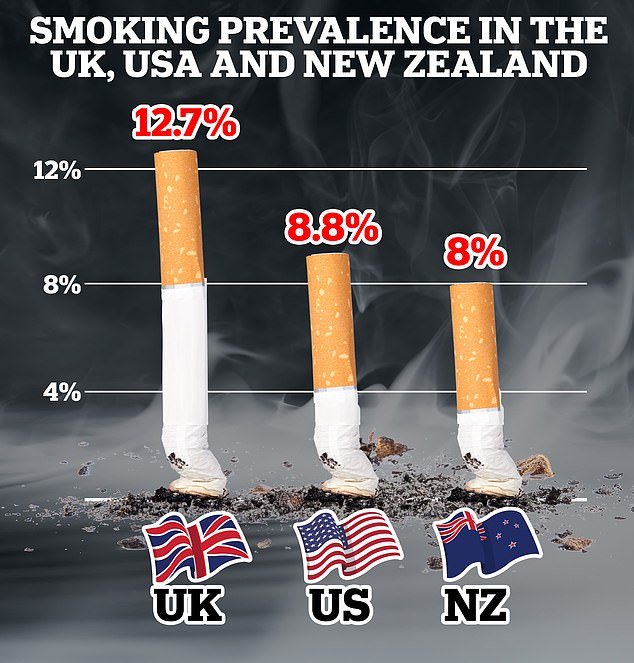How teenage smoking rates have fallen EIGHTFOLD since the 1980s, amid Britain’s war on tobacco, which has made lighting up lights ‘uncool’ – as an interactive map shows that in parts of the country a quarter of of adults smoke
Teen smoking rates are now eight times lower than in the 1980s, thanks to the government’s war on tobacco.
Only 3 percent of 15-year-olds in England now smoke, official figures show.
By comparison, a quarter did this in 1982. Interest rates fell most rapidly in the early 1990s, according to a landmark study by the NHS.
Experts say the introduction of modern anti-smoking laws, such as selling cigarettes in plain packaging, is responsible for the huge decline.
Other tough measures taken over the past two decades include the installation of graphic warning labels depicting the harmful health effects of all types of tobacco and the banning of smoking in restaurants, pubs and nightclubs.
Generation Z would now consider the deadly habit uncool. Social media users came across model Kylie Jenner when she was pictured smoking on Instagram in 2019. One fumed: ‘She smokes. Unfollow. I thought you were cool.” Another said bluntly: ‘Quit smoking’

Last year, actor Cole Sprouse was branded a “cringer” during an interview on the Call Her Daddy podcast for smoking indoors. Others joked that he managed to make cigarette smoking look ‘uncool’ and that this should be the next face of an anti-smoking commercial
Generation Z would now consider the deadly habit uncool.
Social media users came across model Kylie Jenner when she was pictured smoking on Instagram in 2019.
One fumed: ‘She smokes. Unfollow. I thought you were cool.” Another commented bluntly, “Quit smoking.”
Last year, Disney star Cole Sprouse was also branded a “cringer” for smoking indoors during an interview on the Call Her Daddy podcast.
Others joked that he managed to make cigarette smoking look ‘uncool’ and that this should be the next face of an anti-smoking commercial.
The latest teen figures for 2021 show that only four percent of boys aged 15 and three percent of girls now smoke.
This marked a threefold decrease from just ten years earlier, when 11 percent burned regularly.
The sharpest decline occurred between 2006 and 2012, when overall rates halved from 20 to 10 percent.
The same policy has also reduced the number of smokers among adults.
Nationally, only around one in eight people in Britain smoke. Nearly half did so in the mid-1970s, according to data collected by Action on Smoking and Health (ASH) and NHS England.
However, there are still large differences in rates across the country.
Around one in four are still lighting up in some local authorities in England, such as mid-Devon (25.1 per cent) and Hastings (23.7 per cent).
But only 2.9 percent of adults smoke in Stafford (2.9 percent).
Rushcliffe in Nottinghamshire recorded a similarly low figure, with just 4 per cent of adults still lighting up.
Only seven of around 300 local areas currently meet the smoke-free target of less than five per cent by 2030.
MailOnline has compiled smoking data collected by the Office for National Statistics’ Annual Population Survey into an interactive map.
It comes as Rishi Sunak’s bold plan to ban the next generation from ever smoking moved a step closer to becoming law yesterday.
Under the bill, which MPs supported by 383 to 67 last night, anyone born after 2009 will never be able to legally buy tobacco again.
If ultimately passed, it would mean that children 15 or younger today would never be legally sold a cigarette again.
Mr Sunak’s main smoking proposal also focuses on vapes.
MInisters would also be given powers to restrict flavors and promotion of the gadgets in a bid to thwart the UK’s e-cigarette epidemic among children.
This could change the way nicotine-laden vapes are displayed in stores, moving them away from other products such as candy. They would have a limited flavor and be sold in plain, tobacco-like packaging.

The Organization for Economic Co-operation and Development’s 2023 health report shows that 12.7 percent of Britons over the age of 15 smoke cigarettes every day, far more than in the US and New Zealand, the latter of which recently introduced a similar phased smoking ban
Council officers will also be given the power to issue on-the-spot fines of £100 to shops caught breaking the rules.
However, the smoking proposals have long been criticized as ‘illiberal’ by critics.
They also fear that health chiefs will soon be eyeing the crackdown on sugar, caffeine and alcohol, calling the move a ‘slippery slope’.
Fifty-nine Tory MPs – including six government ministers – opposed the plans last night.
They included Kemi Badenoch, Steve Baker and ex-cabinet ministers Suella Braverman, Sir Simon Clarke and Sir Jacob Rees-Mogg.
More than 100 Tories also did not vote, leaving only 165 of 347 voters supporting the bill.
Responding to the backlash against the ban, England’s chief medical officer yesterday rejected the ‘pro-choice’ arguments.
Professor Sir Chris Whitty instead argued that cigarettes are a product ‘designed to deprive you of choice’.
The government believes the phased ban, which will see the legal age for purchasing tobacco increased by one year every year from 2027, will result in 1.7 million fewer people smoking by 2075.
It predicts the move will save tens of thousands of lives and prevent up to 115,000 cases of stroke, heart disease, lung cancer and other lung diseases.
The approach was initially recommended in a government-commissioned report published in 2022 by ex-children’s charity chief Javed Khan..
Smoking kills around 78,000 people in Britain every year, and many more suffer from diseases as a result of their habit – half of which are due to cardiovascular diseases such as heart attack and stroke.
It is estimated that around 500,000 hospital admissions in England each year are due to smoking and that smoking costs the economy £17 billion per year.
Of this, £2.4 billion goes to the NHS, £1.19 billion to the social care system, and over £13 billion is lost in productivity costs due to tobacco-related lost income, unemployment and premature deaths.
The 7,000 chemicals in tobacco – including tar and others that can narrow arteries and damage blood vessels – are thought to be responsible for some of the damage smoking does to the heart.
Meanwhile, nicotine – a highly addictive toxin found in tobacco – is strongly linked to dangerous increases in heart rate and blood pressure.
Smoking also releases toxic gases such as carbon monoxide, which replaces oxygen in the blood, reducing the availability of oxygen to the heart.
